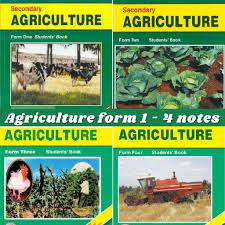TEACHERS NAME . TSC NO .
SCHOOL/INSTITUTION
FORM: TWO
SUBJECT: AGRICULTURE TOPIC: SOIL FERTILITY II (INORGANIC FERTILIZERS)
SUB TOPIC: MACRO-NUTRIENTS
WEEK: TWO LESSON NO: ONE
DATE . TIME
OBJECTIVES:
At the end of the lesson the learner should be able to:
At the end of the lesson the learner should be able to:
- Describe the source of the plant nutrients
- Name the broad categories of the plant nutrients
- Name the major nutrients required by the plants in large quantities
- Discuss the fertilizer elements and the liming elements required by the plants
| TIME | CONTENT | LEARNING ACTIVITIES | RESOURCE MATERIALS |
| 5 Mins
30 Mins
5 Mins |
Introduction
Introduce the lesson by briefly explaining to the learners the content of the topics the mode of coverage of the topic and the objectives to be achieved by the end of the chapter coverage.. Lesson development Step 1 Describing the broad categories of the plant nutrients; Introduction
Essential Elements
Ø Macronutrients Ø micronutrients Step 2 Naming the major nutrients required by the plants; Macro-nutrients · These are also referred to as major nutrients. · They are required by the plant in large quantities. They include;
Step 3 Discussing the fertilizer elements and the liming elements required by the plants;
Conclusion Review the lesson by briefly explaining the main categories of the plants nutrients, naming the major nutrients by the plants and the fertilizer elements and the liming elements required by the plants. |
Description of terms
Asking and answering questions
Description Naming Discussion
Explanation
Discussion
Questions
Description
Definition of terms Questions and answer |
KLB Agriculture book two page 1
Test and fix it KCSE revision agriculture
Certificate secondary agriculture book two
Chalk board
KLB agriculture book two page 1
Class notes
Text book Chalk board
KLB agriculture book two page 1 Longhorn secondary agriculture book two page 1 |
SELF EVALUATION:
Download more free unlimited Agriculture Resources Here:
AGRICULTURE SCHEMES OF WORK FORM ONE TO FOUR: UPDATED
Agriculture notes free pdf download (Form 1-4)
AGRICULTURE REVISION QUESTIONS AND ANSWERS F1-4
Agriculture KCSE Topical Questions and Answers Form 1-4 (All subjects)
FORM ONE FREE AGRICULTURE NOTES
AGRICULTURE KCSE REVISION BOOKLET: F1-4 QUESTIONS (EXAMS) AND ANSWERS

TEACHERS NAME .TSC NO .
SCHOOL/INSTITUTION
FORM: TWO
SUBJECT: AGRICULTURE TOPIC: SOIL FERTILITY II (INORGANIC FERTILIZERS)
SUB TOPIC: NITROGEN
WEEK: TWO LESSON NO: TWO
DATE .TIME
OBJECTIVES:
At the end of the lesson the learner should be able to:
- Explain the various forms in which nitrogen occurs
- Discuss the role of nitrogen in plants
- Describe the symptoms of nitrogen deficiency in plants
| TIME | CONTENT | LEARNING ACTIVITIES | RESOURCE MATERIALS |
| 5 Mins
30 Mins
5 Mins |
Introduction
Introduce the lesson by briefly explaining the main categories of the plants nutrients, naming the major nutrients by the plants and the fertilizer elements and the liming elements required by the plants. Lesson development Step 1 Explaining the forms in which nitrogen occurs; Nitrogen.( N03–, NH4+) Its sources are; artificial fertilizers, organic matter and atmospheric fixation by lightning and nitrogen fixing bacteria. Step 2 Discussing he role of nitrogen in plants; Role of nitrogen in plants 1. Chlorophyll formation making the plant succulent deep green in colour. 2. Encourages vegetative growth especially in crops where leaves are harvested e.g. kales, Cabbages and pasture grasses. 3. Protein formation and protoplasm of all living cells. 4. Regulates the availability of phosphorous and potassium in plants. 5. Increases the size of grain cereals and their protein content. Step 3 Escribing the nitrogen deficiency symptoms in plants; Deficiency symptoms 1. Chlorosis or yellowing of the leaves. 2. Production of anthocyanin pigment instead of chlorophyll in tomatoes causing purplish colour. 3. Stunted growth where plants become dwarfed with extremely short roots. 4. Premature leaf fall. 5. Premature ripening of fruits. 6. Production of light seeds. Effects of excess nitrogen 1. Scorching of the leaves. 2. Delayed maturity. 3. Excessive succulence in stems hence fall/lodging. Loss of nitrogen from the soil 1. Soil erosion 2. Leaching 3. Volatilization 4. Crop uptake 5. Used by microorganisms Conclusion Review the lesson by briefly describing the forms in which oxygen exists in the soil, the role of nitrogen in the soil, symptoms of the nitrogen deficiency and the ways through which nitrogen is lost in the soil |
Description of terms
Asking and answering questions
Description Naming Discussion
Explanation
Discussion
Questions
Description
Definition of terms Questions and answer |
KLB Agriculture book two page 1
Test and fix it KCSE revision agriculture
Certificate secondary agriculture book two
Chalk board
KLB agriculture book two page 2
Class notes
Text book Chalk board
KLB agriculture book two page 2 Longhorn secondary agriculture book two page 2-3 |
SELF EVALUATION:





